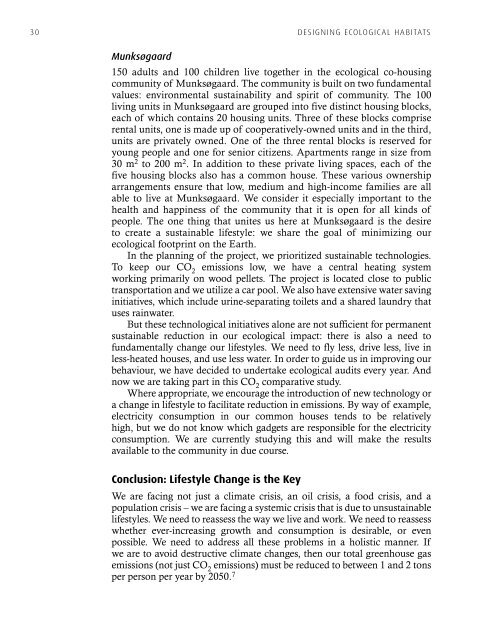Designing Ecological Habitats - Gaia Education
Designing Ecological Habitats - Gaia Education
Designing Ecological Habitats - Gaia Education
Create successful ePaper yourself
Turn your PDF publications into a flip-book with our unique Google optimized e-Paper software.
30 <strong>Designing</strong> ecological <strong>Habitats</strong><br />
Munksøgaard<br />
150 adults and 100 children live together in the ecological co-housing<br />
community of Munksøgaard. The community is built on two fundamental<br />
values: environmental sustainability and spirit of community. The 100<br />
living units in Munksøgaard are grouped into five distinct housing blocks,<br />
each of which contains 20 housing units. Three of these blocks comprise<br />
rental units, one is made up of cooperatively-owned units and in the third,<br />
units are privately owned. One of the three rental blocks is reserved for<br />
young people and one for senior citizens. Apartments range in size from<br />
30 m2 to 200 m2 . In addition to these private living spaces, each of the<br />
five housing blocks also has a common house. These various ownership<br />
arrangements ensure that low, medium and high-income families are all<br />
able to live at Munksøgaard. We consider it especially important to the<br />
health and happiness of the community that it is open for all kinds of<br />
people. The one thing that unites us here at Munksøgaard is the desire<br />
to create a sustainable lifestyle: we share the goal of minimizing our<br />
ecological footprint on the Earth.<br />
In the planning of the project, we prioritized sustainable technologies.<br />
To keep our CO2 emissions low, we have a central heating system<br />
working primarily on wood pellets. The project is located close to public<br />
transportation and we utilize a car pool. We also have extensive water saving<br />
initiatives, which include urine-separating toilets and a shared laundry that<br />
uses rainwater.<br />
But these technological initiatives alone are not sufficient for permanent<br />
sustainable reduction in our ecological impact: there is also a need to<br />
fundamentally change our lifestyles. We need to fly less, drive less, live in<br />
less-heated houses, and use less water. In order to guide us in improving our<br />
behaviour, we have decided to undertake ecological audits every year. And<br />
now we are taking part in this CO2 comparative study.<br />
Where appropriate, we encourage the introduction of new technology or<br />
a change in lifestyle to facilitate reduction in emissions. By way of example,<br />
electricity consumption in our common houses tends to be relatively<br />
high, but we do not know which gadgets are responsible for the electricity<br />
consumption. We are currently studying this and will make the results<br />
available to the community in due course.<br />
Conclusion: Lifestyle Change is the Key<br />
We are facing not just a climate crisis, an oil crisis, a food crisis, and a<br />
population crisis – we are facing a systemic crisis that is due to unsustainable<br />
lifestyles. We need to reassess the way we live and work. We need to reassess<br />
whether ever-increasing growth and consumption is desirable, or even<br />
possible. We need to address all these problems in a holistic manner. If<br />
we are to avoid destructive climate changes, then our total greenhouse gas<br />
emissions (not just CO2 emissions) must be reduced to between 1 and 2 tons<br />
per person per year by 2050. 7







